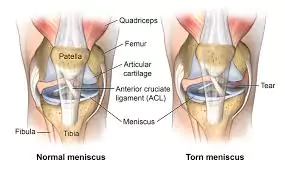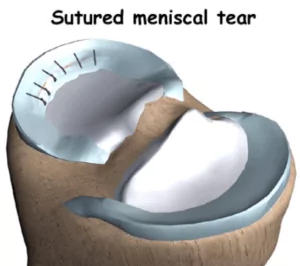Knee Pain Treatment In Pune
The treatment for knee pain depends on the underlying cause of the pain. Here are some general treatments that may help alleviate knee pain:
Rest and ice: Resting the knee and applying ice for 15-20 minutes several times a day can help reduce swelling and pain.
Compression: Wearing a compression bandage or brace on the knee can provide support and reduce swelling.
Elevation: Elevating the knee above the level of the heart can also help reduce swelling.
Pain medication: Over-the-counter pain medication such as acetaminophen or ibuprofen can help alleviate pain and reduce inflammation.
Physical therapy: Exercises that help strengthen the muscles around the knee and improve flexibility can help reduce pain and prevent future injuries.
Surgery: If the knee pain is caused by a serious injury or condition, such as a torn ligament or osteoarthritis, surgery may be necessary.
It’s important to consult with a doctor to determine the underlying cause of knee pain and develop a treatment plan that is appropriate for the individual.
Knee Meniscus Tear Treatment In Pune :

The meniscus is a cushion between the upper and lower bone of the knee. It prevents friction between bones in the knee joint and gives stability to the knee joint. A most common reason for meniscus injury is sports and road traffic accidents. The medial knee meniscus is injured most commonly. Meniscus tear treatment is successfully done nowadays with advanced technique and instrumentations of arthroscopy (Keyhole surgery).

Knee joint and ligaments Meniscus Tear Treatment In Pune
The weight-bearing surfaces of the knee are covered with a layer of protective cartilage. There are also “shock absorbers” on either side of the knee joint between the cartilage held in the femur and the tibia. These shock absorbers are formally named the medial meniscus and the lateral meniscus. These are horseshoe shaped and help to both centers the knee joint during activity and minimize the stress on articular cartilage.
The medial and lateral collateral ligaments stabilize the knee from side-to-side, allowing the knee to hinge into flexion (bent position) and extension (straightened position).
In knee replacement surgery the anterior cruciate ligament (ACL) is one of a pair of ligaments in the middle of the knee joint that forms a cross, hence the name “cruciate.” There are an anterior cruciate ligament and a posterior cruciate ligament (PCL) in the knee. Both of these ligaments stabilize the knee from front to back during normal activity or physical exertion.
Symptoms of Meniscus Knee injury

- Pain- If you have a minor injury, you may not feel pain. You may feel sore along your knee’s joint line. Some people have trouble standing or putting pressure on the hurt leg.
- Swelling– This is most likely to happen during the first 24 hours. You can reduce swelling by putting ice on your knee and elevating (rising) your leg by propping it up on a pillow.
- Trouble walking– If you’re able to put pressure on your hurt leg, you may notice that it’s harder than normal to walk. Some people find that the knee joint feels looser than it should.
- Less range of motion– After you damage your meniscus, it’s very likely that you won’t be able to bend and flex your knee like you normally would.
- Locking of the knee–
- Clicking sounds from joint-

How it happens….
Most meniscus knee injuries happen during sports and fitness activities that can put stress on the knee:
- Suddenly slowing down and changing direction (cutting)
- Pivoting with your foot firmly planted
- Landing from a jump incorrectly
- Stopping suddenly
- Receiving a direct blow to the knee
Meniscus Tear Treatment in PCMC Options
Non-operative treatment-
In physiotherapy, a course of physical therapy may relieve pain for individuals who are relatively inactive, engage in moderate exercise and recreational activities, or play sports that put less stress on the knees.
Operative treatment-
Arthroscopic knee meniscus surgery is generally recommended if:
- You’re an athlete and want to continue in your sport, especially if the sport involves jumping, cutting or pivoting
- More than one ligament with the meniscus in your knee is injured
- The injury is causing your knee to buckle during everyday activities
- You’re young (though other factors, such as activity level and knee instability, are more important than age)
Arthroscopic Meniscus tear surgery in pcmc

Meniscus injury surgery nowadays with the help of advanced science and technology have done by keyhole surgery that is Knee arthroscopic surgery. Depending on the size and pattern of tear, surgery options have opted.
- Partial Meniscectomy- an Injured portion of the meniscus is removed
- Meniscus repair- an Injured portion of the meniscus is sutured with suture anchors

Advantages of Arthroscopic Meniscus tear surgery in pune
- Postoperative pain is greatly reduced due to the minimally invasive character of the surgical intervention (arthroscopy) and to the smaller size of the wound. Recovery is early.
- Good mobility of the knee is obtained very rapidly.
- Active mobilization of the patient is early.
- Through the faster postoperative recovery and the significant decrease of the postinterventional pain, the hospitalization costs are substantially decreased by lowering the dose of analgesics and anti-inflammatory medication, and particularly by reducing the period of hospital stay (from 1 to 2days on the average).
Recovery After Meniscus Tear Treatment In Pcmc

After knee replacement surgery patient has to perform physiotherapy to regain power and movement of the knee joint. After surgery patient will start to walk from the next day. Physiotherapy to alleviate pain and swelling, restore range of motion (ROM) and strength, and improve mobility. Physical therapy for the knee joint is divided into phases. By following this protocol, or one similar, you should be able to walk after meniscus tear surgery in pune by the end of the third to six weeks after your operation. Of course, everyone heals and responds to treatment at different rates. If you’re planning to have Knee Pain Treatment In Pune, here’s a general idea of what to expect when you start physical therapy afterward.

Advantages of Knee pain Treatment
- Lower need for medications
- Lower need for surgery
- Improved mobility
- Improved balance
- Reduced pain in the future
Orthopedician or orthopedic doctors specialize in treating bone and joint-related problems. Ideally, when your knee is paining, you should visit an orthopedic doctor for treatment.
Genicular nerve radiofrequency ablation is a minimally invasive treatment for knee pain due to osteoarthritis of the knee, and can significantly reduce pain, especially for adults who are 50 and older
Walking as a form of exercise has enormous benefits, particularly for older adults. It’s easy on the joints and helps boost heart health and improve circulation and balance. And new research now suggests that taking a walk can reduce and prevent knee pain related to osteoarthritis, the most common form of arthritis
” PAIN FREE LIFE JUST A CLICK AWAY “
Incoming Tag- Meniscus Tear Treatment in Pune, Meniscus injury Treatment in Pune, Meniscus knee treatment in Pune, Meniscus knee treatment in Pimpri Chinchwad (PCMC), knee pain treatment in Pune, , Knee Pain Treatment In Pcmc, meniscus tear in pune, meniscus tear in pcmc, Meniscus Tear surgery in Pune, Meniscus Tear surgery in pcmc, Meniscus Tear Treatment in kharadi, chandan nagar
